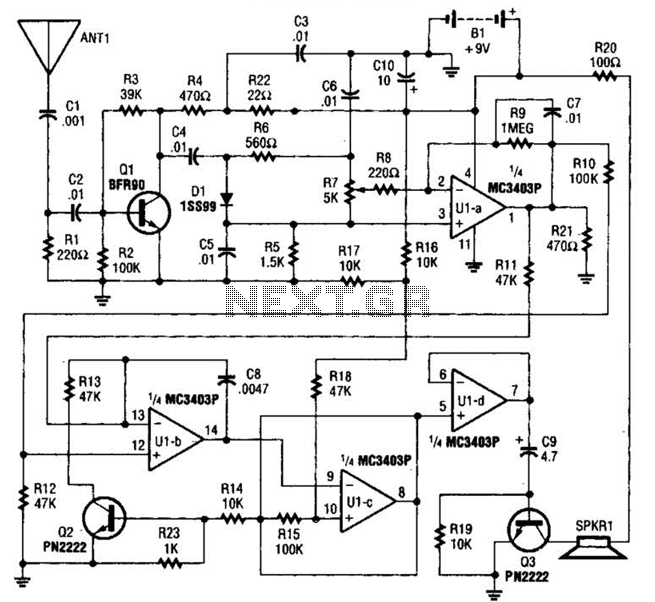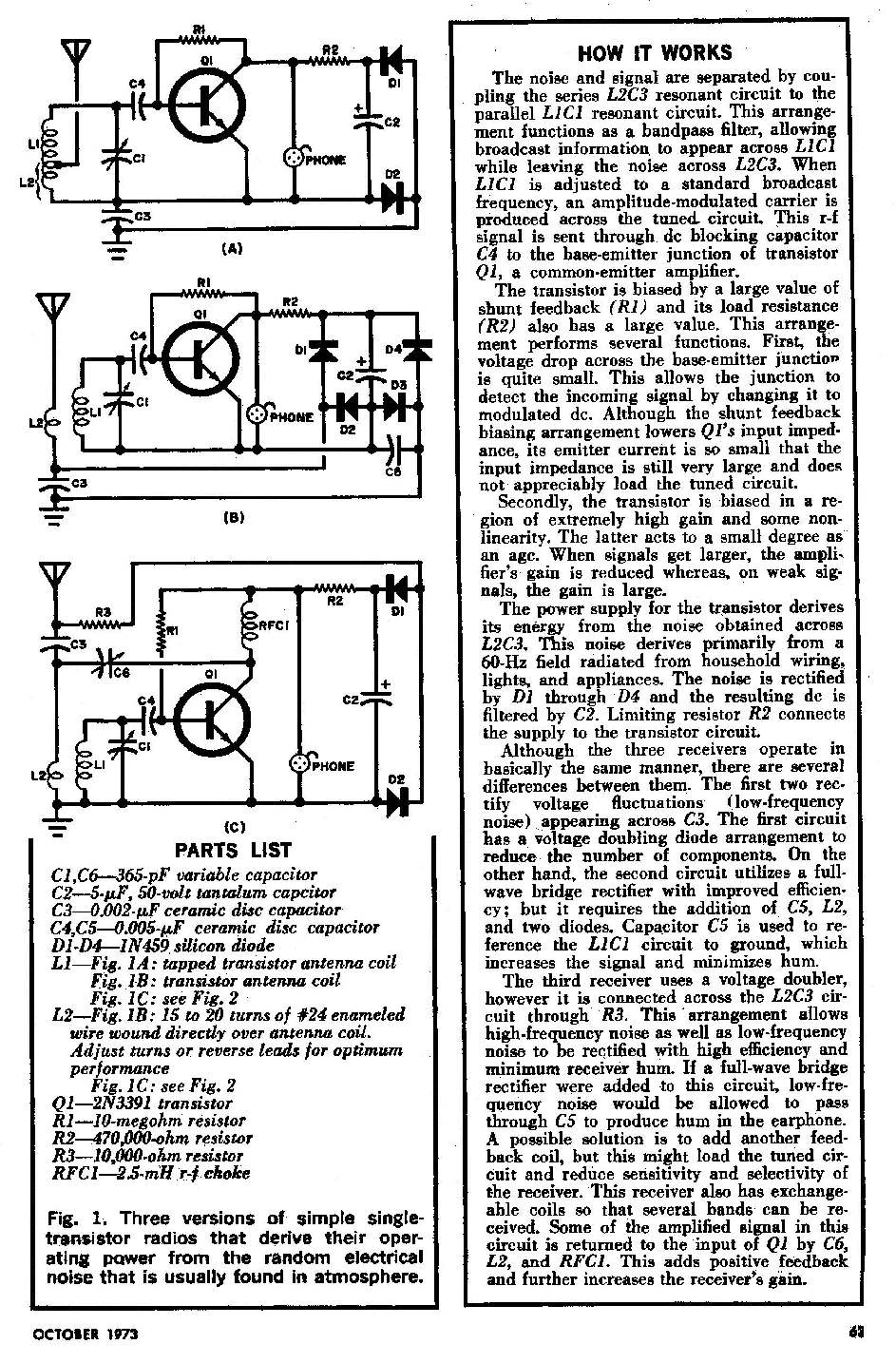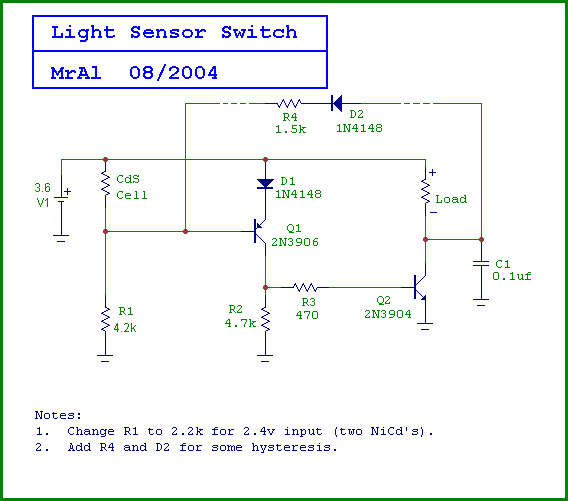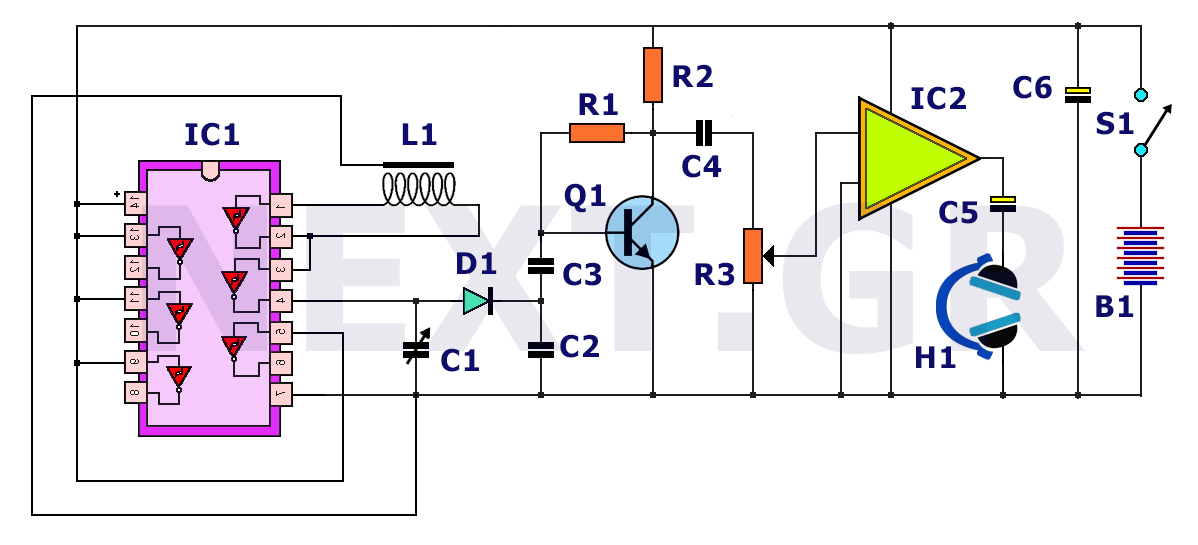
Metal detector 4

The metal detector circuit comprises a detection oscillator, a reference oscillator, a mixer, and a signal display, as illustrated in Figure 8-70. The detection oscillator circuit is made up of the time base oscillator IC1, inductor L1, potentiometer RP1, diode VD1, and capacitors C1 and C2. The reference oscillator circuit consists of the time-base integrated circuit IC2, inductor L2, diode VD2, resistor R1, and capacitors C3 and C4. The mixer includes a transistor V, diode VD3, and resistors R2 to R4. The signal display circuit features integrated circuit IC3, a voltage meter RC PV, and additional peripheral components. Resistors R1 to R7 should be selected as 1/4W or 1/8W carbon film types. RP1 utilizes a synthetic membrane potentiometer with a switch, while RP2 employs a synthetic membrane potentiometer without a switch or a variable resistor. Capacitors C1, C2, C4, C5, and C7 are ceramic types; capacitor C6 is an aluminum electrolytic capacitor rated above 10V. Diodes VD1 to VD3 can be 2AP9, 2AP10 common germanium diodes, or from the 2AK series of switching diodes. Transistor V can be either a 3DG6 or S9018 silicon NPN type.
The metal detector circuit operates by utilizing both detection and reference oscillators to identify the presence of metallic objects. The detection oscillator generates a frequency based on the inductive properties of the coil L1, which is influenced by nearby metal. The output of this oscillator is mixed with the reference oscillator's signal in the mixer stage, where the resulting frequency shift indicates the presence of metal.
The detection oscillator is initiated by IC1, which is responsible for generating a stable time base. The inductor L1, along with the potentiometer RP1, allows for tuning the circuit to different frequencies, optimizing sensitivity to various metal types. The diode VD1 rectifies the oscillating signal, while capacitors C1 and C2 filter out any noise, ensuring a clean signal for further processing.
The reference oscillator circuit, comprised of IC2, L2, R1, and capacitors C3 and C4, establishes a stable reference frequency against which the detection signal can be compared. The inductor L2 is crucial for maintaining the oscillation, while R1 and the capacitors provide the necessary timing characteristics.
The mixer stage, consisting of transistor V and diodes VD3, combines the detection and reference signals. Resistors R2 to R4 set the gain and biasing conditions for the transistor, ensuring optimal operation. The output from this stage produces an audio or visual signal that indicates the presence of metal.
Finally, the signal display circuit, which includes IC3 and a voltage meter, presents the detection results to the user. The choice of components, such as the carbon film resistors and ceramic capacitors, ensures reliability and performance. The use of synthetic membrane potentiometers allows for precise adjustments in sensitivity, while the selection of diodes and transistors further enhances the circuit's efficiency and response time. This comprehensive design allows for effective metal detection in various applications.The metal detector circuit consists of detection oscillator, reference oscillator, mixer and signal display, it is shown as Figure 8-70. The detection oscillator circuit is composed of the time base oscillator ICl, inductor Ll, potentiometer RPl, diode VDl and capacitors Cl, C2.
Reference oscillator (reference oscillator) circuit is composed of the time-base integrated circuit IC2, inductor L2, diode VD2, resistor Rl and capacitors C3, C4. Mixer is composed of the transistor V, diode VD3 and resistors R2-R4. Signal display circuit consists of integrated circuit IC3, voltage meter RC PV and peripheral components. Rl-R7 choose 1/4W or 1/8W carbon film resistors. RPl uses synthetic membranes potentiometer with switch; RP2 uses synthetic membrane potentiometer without switch or variable resistor.
Cl-C5, C7 use ceramic capacitors; C6 uses the aluminum electrolytic capacitor with the voltage being greater than lOV. VDl-VD3 use 2AP9, 2APlO common germanium germanium diode or 2AK series switching diode. V uses 3DG6 or S9018 silicon NPN transistor. 🔗 External reference
The metal detector circuit operates by utilizing both detection and reference oscillators to identify the presence of metallic objects. The detection oscillator generates a frequency based on the inductive properties of the coil L1, which is influenced by nearby metal. The output of this oscillator is mixed with the reference oscillator's signal in the mixer stage, where the resulting frequency shift indicates the presence of metal.
The detection oscillator is initiated by IC1, which is responsible for generating a stable time base. The inductor L1, along with the potentiometer RP1, allows for tuning the circuit to different frequencies, optimizing sensitivity to various metal types. The diode VD1 rectifies the oscillating signal, while capacitors C1 and C2 filter out any noise, ensuring a clean signal for further processing.
The reference oscillator circuit, comprised of IC2, L2, R1, and capacitors C3 and C4, establishes a stable reference frequency against which the detection signal can be compared. The inductor L2 is crucial for maintaining the oscillation, while R1 and the capacitors provide the necessary timing characteristics.
The mixer stage, consisting of transistor V and diodes VD3, combines the detection and reference signals. Resistors R2 to R4 set the gain and biasing conditions for the transistor, ensuring optimal operation. The output from this stage produces an audio or visual signal that indicates the presence of metal.
Finally, the signal display circuit, which includes IC3 and a voltage meter, presents the detection results to the user. The choice of components, such as the carbon film resistors and ceramic capacitors, ensures reliability and performance. The use of synthetic membrane potentiometers allows for precise adjustments in sensitivity, while the selection of diodes and transistors further enhances the circuit's efficiency and response time. This comprehensive design allows for effective metal detection in various applications.The metal detector circuit consists of detection oscillator, reference oscillator, mixer and signal display, it is shown as Figure 8-70. The detection oscillator circuit is composed of the time base oscillator ICl, inductor Ll, potentiometer RPl, diode VDl and capacitors Cl, C2.
Reference oscillator (reference oscillator) circuit is composed of the time-base integrated circuit IC2, inductor L2, diode VD2, resistor Rl and capacitors C3, C4. Mixer is composed of the transistor V, diode VD3 and resistors R2-R4. Signal display circuit consists of integrated circuit IC3, voltage meter RC PV and peripheral components. Rl-R7 choose 1/4W or 1/8W carbon film resistors. RPl uses synthetic membranes potentiometer with switch; RP2 uses synthetic membrane potentiometer without switch or variable resistor.
Cl-C5, C7 use ceramic capacitors; C6 uses the aluminum electrolytic capacitor with the voltage being greater than lOV. VDl-VD3 use 2AP9, 2APlO common germanium germanium diode or 2AK series switching diode. V uses 3DG6 or S9018 silicon NPN transistor. 🔗 External reference





